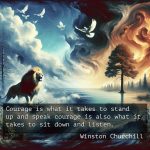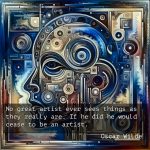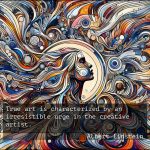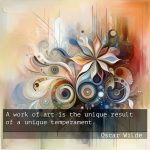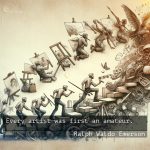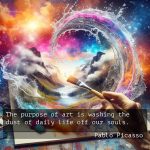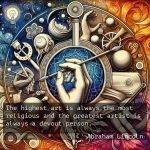This website uses cookies so that we can provide you with the best user experience possible. Cookie information is stored in your browser and performs functions such as recognising you when you return to our website and helping our team to understand which sections of the website you find most interesting and useful.

Winston Churchill Quotes on Art
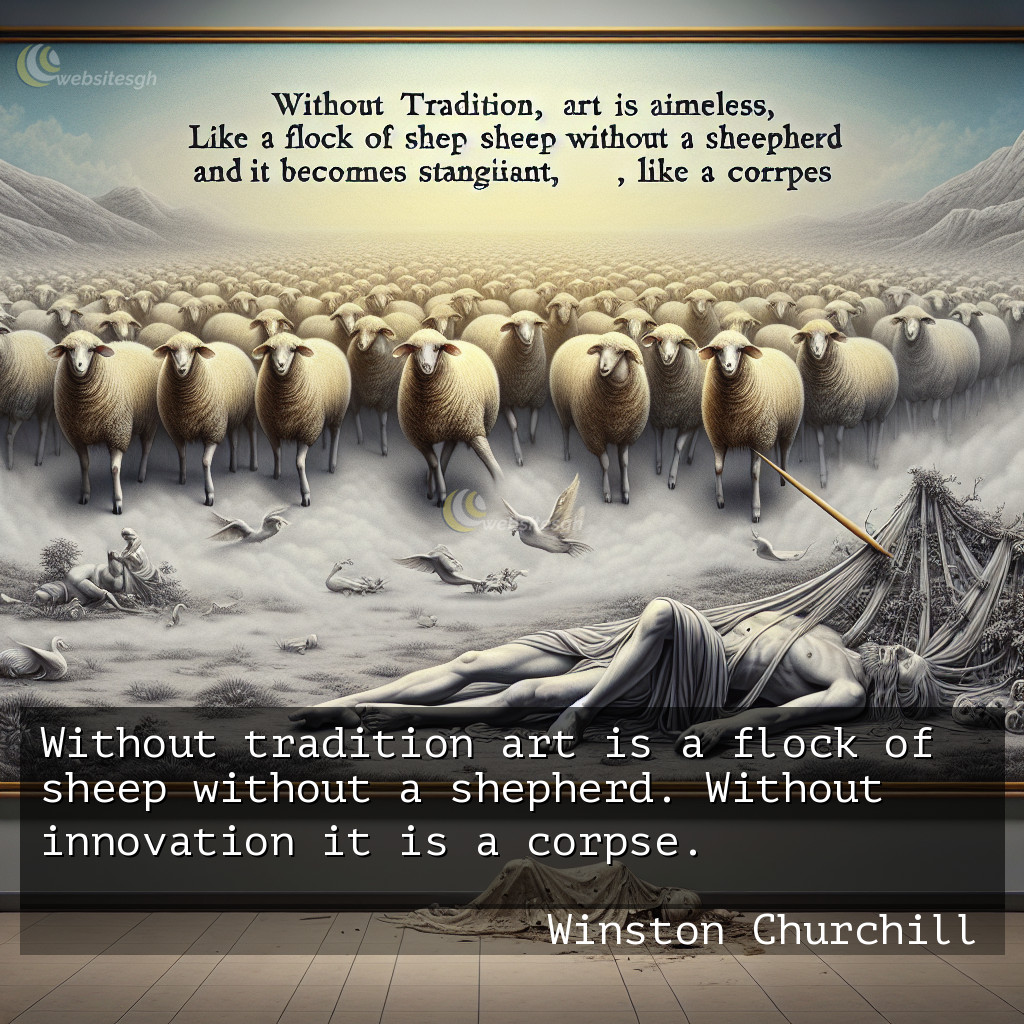
Winston Churchill Quotes on Art 7UW9
Without tradition art is a flock of sheep without a shepherd. Without innovation it is a corpse.
By: Winston Churchill
The Balance of Tradition and Innovation in Art and Life
Tradition and innovation are two forces that shape not only the world of art but also the very fabric of our lives. The quote, “Without tradition, art is a flock of sheep without a shepherd. Without innovation, it is a corpse,” attributed to Winston Churchill, encapsulates the delicate balance between the old and the new, the established and the groundbreaking. This balance is not just relevant to artists but to anyone striving to lead a productive and fulfilling life.
Tradition provides us with a foundation, a set of principles, and a history from which we can draw lessons and inspiration. It is the shepherd that guides the flock, offering direction and a sense of belonging. In life, our traditions might be our cultural practices, the wisdom of our ancestors, or the tried-and-true methods of accomplishing tasks. They give us a starting point and a sense of identity.
However, clinging too tightly to tradition can stifle creativity and progress. That’s where innovation comes in. Innovation is the lifeblood of growth, the spark that keeps the flame of curiosity and progress burning. In art, innovation pushes boundaries and challenges the status quo, breathing new life into old forms. In our lives, it encourages us to find new solutions to problems, to adapt to changing circumstances, and to embrace the future with open arms.
Embracing Tradition in a Fast-Paced World
In a world that often seems obsessed with the new, it’s easy to overlook the value of tradition. Yet, tradition anchors us. It connects us to our past and to each other. In art, traditional techniques and styles form the bedrock upon which new ideas are built. Similarly, in life, our traditions—whether they be family dinners, community service, or simply the way we greet one another—create a sense of continuity and community.
Tradition doesn’t mean stagnation. It’s possible to honor the past while still seeking out new experiences and knowledge. For instance, a musician might study classical compositions to understand the fundamentals of music before experimenting with new genres or technologies. In our personal lives, we might maintain certain family traditions while also being open to creating new ones that reflect the evolving nature of our relationships and society.
Fostering Innovation for a Vibrant Future
While tradition is the bedrock, innovation is the force that propels us forward. In the arts, innovation can take the form of a new painting technique, a novel way of storytelling, or the fusion of different musical styles. In our daily lives, innovation might be as simple as finding a more efficient route to work or as complex as inventing a new form of clean energy.
Innovation requires a willingness to take risks and to accept that failure is often a stepping stone to success. It’s about questioning the status quo and being open to change. Encouraging innovation in young people, especially, is crucial as they will be the ones to face and solve the challenges of the future. Schools and communities that foster creativity and critical thinking are investing in a world that remains vibrant and adaptable.
Striking the Right Balance
Finding the right balance between tradition and innovation is key. Too much reliance on tradition can lead to a lack of progress, while too much innovation without a grounding in tradition can lead to a loss of identity and direction. In art, this balance creates works that are both meaningful and fresh. In life, it allows us to respect and learn from the past while embracing the possibilities of the future.
One way to strike this balance is to approach both tradition and innovation with a mindset of continuous learning. We can study the traditions of our field or culture deeply, understanding their origins and purposes. At the same time, we can stay curious and open to new ideas, always willing to learn and grow.
Another way is to engage in dialogue with others who have different perspectives. By sharing and comparing our traditions and innovations, we can learn from each other and find new ways to blend the old with the new. This exchange of ideas is at the heart of a dynamic and progressive society.
Conclusion: The Dance of Tradition and Innovation
Just like a flock of sheep needs a shepherd to guide it and just as a body needs a spirit to animate it, our lives and our art require the guiding hand of tradition and the animating spark of innovation. By valuing and understanding our traditions, we honor the past and the lessons it offers. By embracing innovation, we ensure that our art, our communities, and our very lives do not become stagnant but continue to evolve and thrive.
Whether you are an artist, a student, an entrepreneur, or simply someone navigating the complexities of modern life, remember the wisdom in Churchill’s words. Let tradition be your guide, and let innovation be your driving force. Together, they create a harmony that can lead to a life of purpose, fulfillment, and continuous improvement.
FAQs about Tradition and Innovation in Art and Life
- What does the quote by Winston Churchill mean?
The quote suggests that both tradition and innovation are essential for art to thrive. Tradition provides guidance and a foundation, while innovation brings vitality and progress. Without either, art would lose its direction or become stagnant.
- How can we apply the balance of tradition and innovation in our lives?
We can apply this balance by respecting and learning from the past while being open to new experiences and ideas. This means maintaining valuable traditions but also being willing to adapt and embrace change when necessary.
- Why is tradition important?
Tradition is important because it gives us a sense of identity, belonging, and continuity. It provides a foundation of knowledge and practices that have been tested over time.
- How does innovation contribute to progress?
Innovation contributes to progress by introducing new ideas, methods, and technologies that challenge the status quo and lead to improvements in various fields, including art, science, and everyday life.
- Can tradition and innovation coexist?
Yes, tradition and innovation can and should coexist. They complement each other, with tradition providing a stable foundation and innovation driving growth and adaptation.
- How can educators encourage innovation in students?
Educators can encourage innovation by fostering a learning environment that values creativity, critical thinking, and problem-solving. They can provide opportunities for students to experiment, take risks, and learn from failures.
- Is it possible to be too traditional or too innovative?
Yes, an excessive focus on tradition can lead to resistance to change and progress, while too much emphasis on innovation without a grounding in tradition can result in a loss of direction and meaning.
- How can we find a balance between tradition and innovation?
We can find a balance by continuously learning about and respecting traditions while staying curious and open to new ideas and approaches. Engaging in dialogue with others and being adaptable also helps maintain this balance.
- What role does failure play in innovation?
Failure is often an integral part of the innovation process. It provides valuable lessons and insights that can lead to better solutions and success in future endeavors.
- Can innovation change traditions?
Yes, innovation can and often does influence traditions. Over time, new ideas and practices can become integrated into traditions, leading to their evolution and relevance in a changing world.
